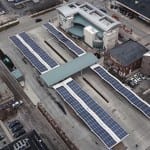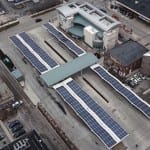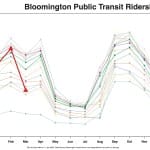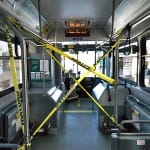COVID-19 means Bloomington Transit holds most new routes in limbo, gives hazard pay to drivers, still looks on sunny side




At its meeting on Tuesday night, Bloomington Transit’s board voted unanimously to approve just one of the new routes that had emerged from a study done by a consultant last year.
The collection of newly designed routes, optimized to increase readership, was presented to the public at meetings held last year in November and December.
The one new route approved by the board will be named Route 2 West 17th Street, replacing the old one called Route 2 West 11th Street via Showers Complex. It will start service later this year on Aug. 24.
The reason for the delayed decision on other routes, until some undetermined future time, is the uncertainty caused by the impact of the COVID-19 pandemic. At whatever point a decision is made on the other routes, implementation is not expected before January 2021.
The COVID-19 pandemic factored into another significant point of business on the board’s meeting agenda. The five-member board retroactively approved various extraordinary measures taken by BT management during the public health emergency, among them time-and-a-half hazard pay for its union drivers.
Not related to the COVID-19 pandemic was a Tuesday agenda item that ratified an amendment to an interlocal agreement between Bloomington Transit and the city of Bloomington. (Bloomington Transit is not a city department.) The interlocal agreement relates to the condominium ownership of the downtown transit center at Walnut and 3rd streets and the installation of solar panels on the center’s canopies that cover the passenger loading areas.
Under the amendment approved on Tuesday night, Bloomington Transit will see a savings of at least $396,451 over a period of 20 years beginning March 1, 2019 due to the installation of solar panels. After 20 years, the city will make up any shortfall between that amount and actual energy savings.

Explaining the staff’s recommendation to the board to postpone consideration of the BT staff-recommended new route configurations, general manager Lew May said, “What the future holds in terms of service is quite unknown at this point.”
Among the uncertainties are the budget impacts, May said. He ticked through the sources of funds where significant drops could be expected.
Fare revenue will be down. Ridership in the second half of March this year was just about 10 percent of the level it was compared to the same period last year.
May said the amount of local income tax that BT receives will likely be affected. The $500,000 in local income tax received by BT each year makes up about five percent of its annual budget. Federal funding, which is sourced from gas taxes will also be affected, May said.
May said the big question for BT is still: How many Indiana University students will return to campus this fall? A decision about the return by students to the physical campus in the fall is expected to emerge from work being done by a collection of university committees that have been established to consider such issues.
It is important to go head with the implementation of the new Route 2, May said, because of the relocation of the Bloomington Township trustee’s office to W. 17th St. from Vernal Pike. The newly aligned route will provide service to that location.
The township trustee has an existing role, independent of COVID-19 impacts, to help provide temporary emergency assistance to help with basic necessities like rent, utilities, food, and medical care.
The new Route 2 lops off the eastern loop of the old route, in the interest of improving on-time performance. May told board members the new Route 2 is budget neutral. The normal pre-pandemic ridership on the route is 800–1,000 passengers a day, May told board members.




Comments ()